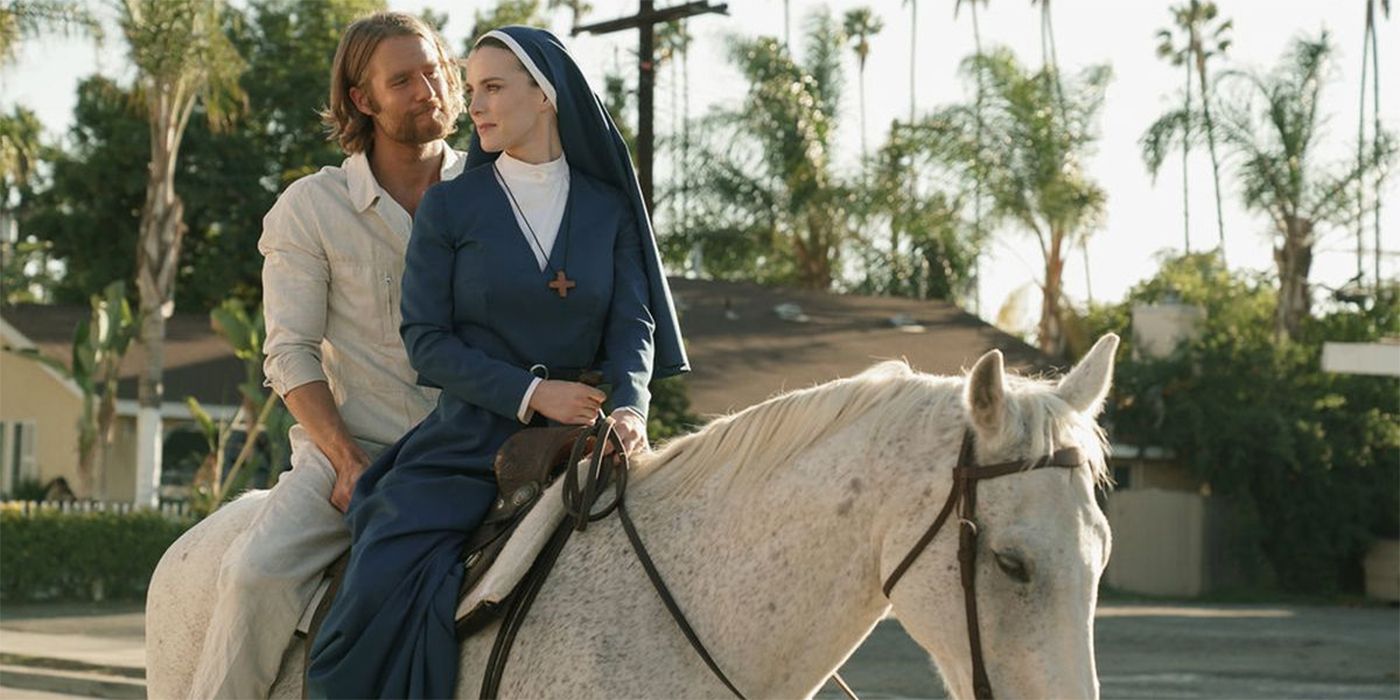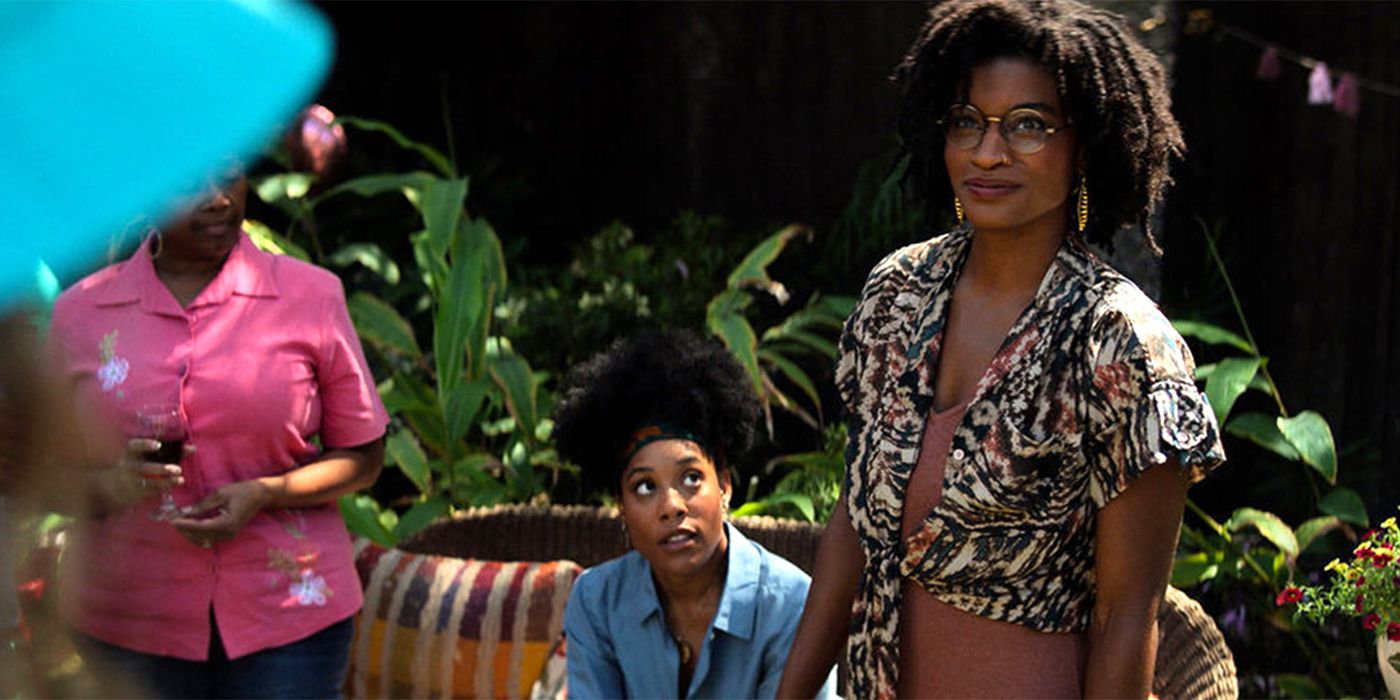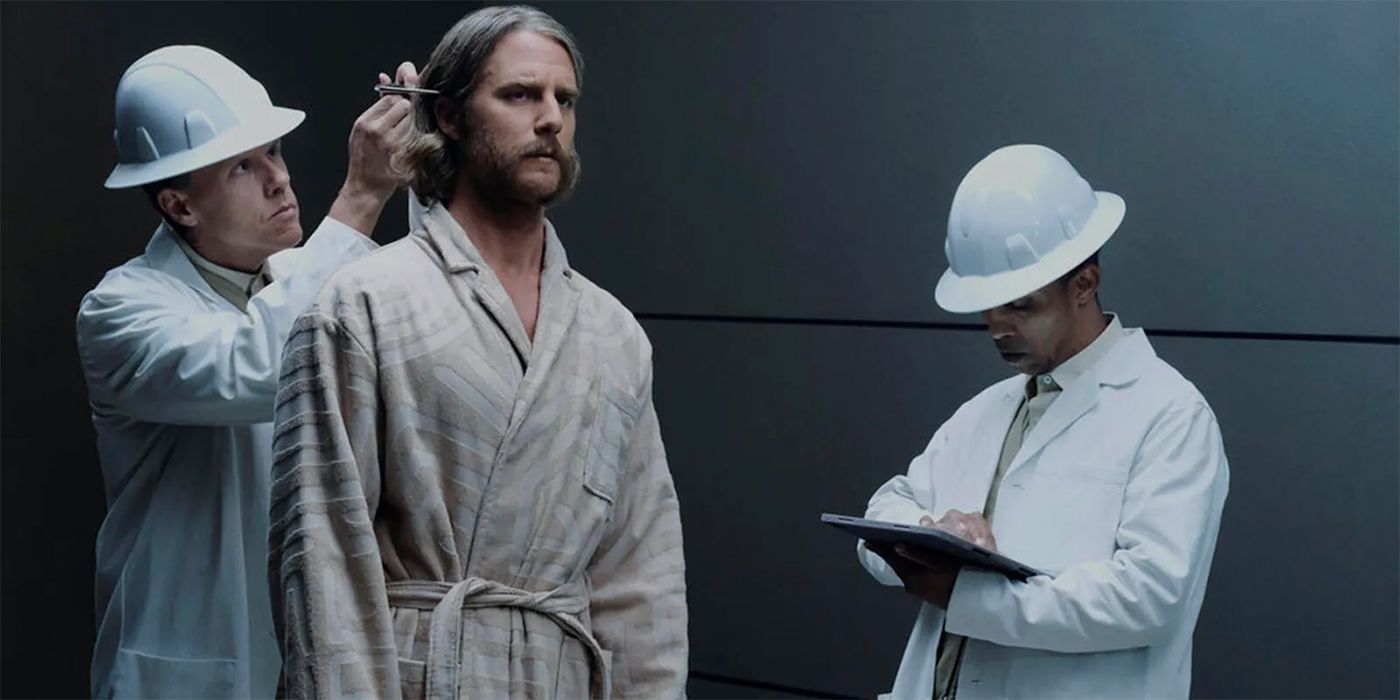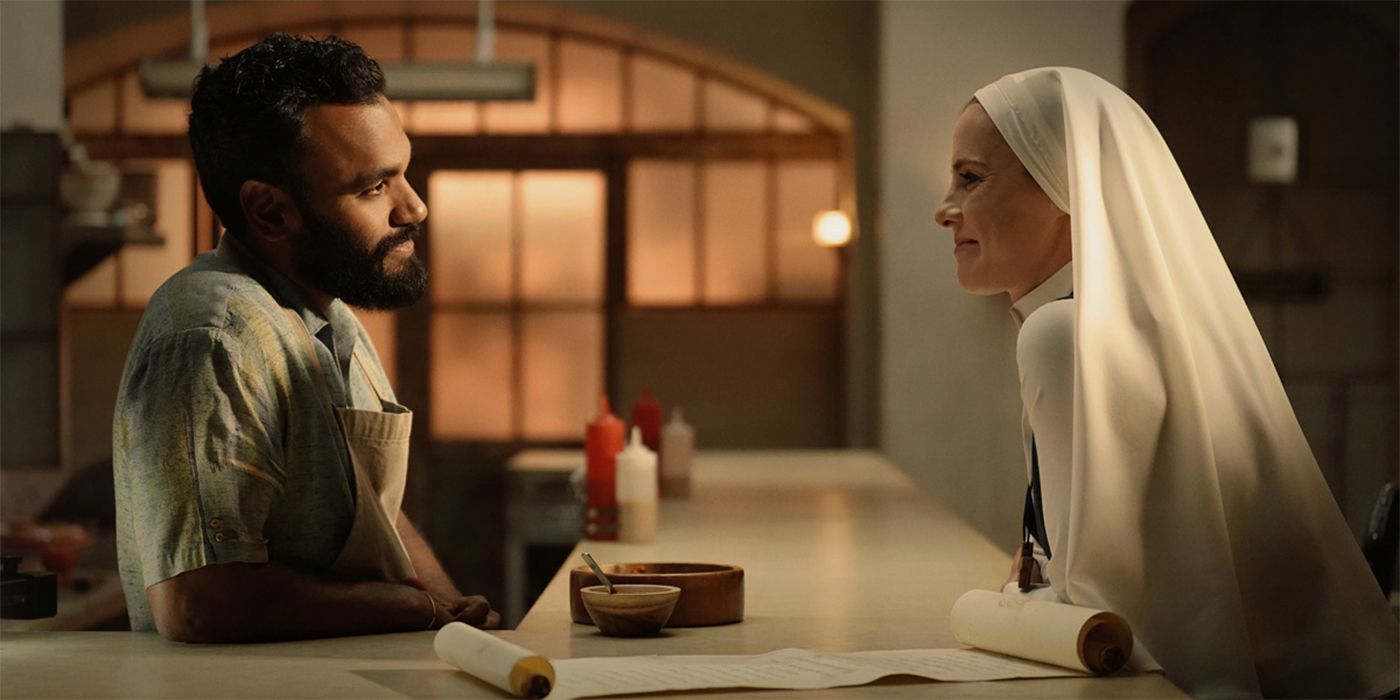Warning: Spoilers for Mrs. Davis episode 8!Peacock's ambitious series Mrs. Davis concluded its run this week, and the AI-run world of the show underwent huge shifts thanks to Simone (Betty Gilpin) completing her mission. The trepidatious nun destroyed the Holy Grail and turned off the supposedly benevolent artificial intelligence that had been haunting her the last several years, but not before discovering that its original purpose was to help Buffalo Wild Wings customers select their favorite flavors.
Each episode of Mrs. Davis has been a wild ride, held together by the impossible charm of Gilpin (who skyrocketed to fame thanks to her unforgettable role in GLOW) and her costars. But the series, which was co-created by Tara Hernandez (Young Sheldon) and Damon Lindelof (The Leftovers), also required a unified aesthetic and steady directorial hand that would defy the tangential nature of individual episodes. While three directors took on the task, it was the BAFTA-nominated Owen Harris (who previously worked on Black Mirror) that helped shape both the beginning and end of the season.
Screen Rant spoke to Harris, who directed the finale (as well as episodes 1, 2, and 5), about how his work of the earlier parts of the season helped shape his vision for the Mrs. Davis finale. The director also explained how certain reveals were executed and shared what he thought of the unusual Jay-Simone-Wiley love triangle.
Owen Harris Talks Mrs. Davis Finale
Screen Rant: You have been along for the Mrs. Davis journey all season. How did directing so many episodes help shape your version of the finale, and was it different from previous shows you've worked on?
Owen Harris: Yeah, it was. I think that a lot of my work had been on one-offs, like films for the BBC and Black Mirror anthologies. Working on a TV show, I think I always felt awkward in terms of going into a show and then saying goodbye. Although often, it works out well, and it's fun and everything.
But when I read Mrs. Davis, I just thought, “Wow, we're only going to have this much fun if someone's really got a firm grip of the rudder.” And so I thought, “I want to be in amongst this. I want to try and land a tone, and then stick to it.” I think I said at one point, “I'll direct all of them if you want me to,” but I think it would've killed me. It nearly did anyhow.
It was fun, though! It just became very apparent that the workload needed to be shared. And I'm really pleased it was because every episode almost felt like a pilot – each one goes off on its own tangent and has its own slightly genre-surfing thing that it does. Working with Alethea [Jones] for three of the episodes and with Frederick [E.O. Toye] for one of them, something to those episodes that allowed us to be playful in different ways. It was just a fabulous piece of material to work on.
Working with Betty across the show was wonderful. Jake, Andy, and all the others – we had an amazing cast and amazing crew. It was really fun to spend some time bedding down and getting on with the show; it was a pleasure.
How did you approach that Joy flashback and the Buffalo Wild Wings reveal? For so much of the scene, you just see NG, and I was wondering how far you could take it.
Owen Harris: Yeah, I think it's really fun if you take things like that to the edge. How much of that sign do we reveal? It's really playful if you do just sew it in there a little bit so that, almost subconsciously, you've had a little whiff of something before. You are following the story, but then when it goes and reveals things, you're like, "This is where I am."
But I think just that the whole Buffalo Wild Wings AI for the Mrs. Davis origin story was baked in from when I got sent the pilot. For me, the playfulness of that storyline absolutely was fundamental to the tone of the entire show. When it gets revealed, everything makes sense in terms of the absurd tangents and the playfulness; all of those breadcrumbs that we've fed the viewer, and just generally how the story's being told. I think the origin of Mrs. Davis is fundamental to that whole tonality.
It's fun to decide how are we going to reveal that, and I think that the character of Joy is fantastic. Again, she's someone who's having a swing at trying to get something out there, and she has a lot of belief in her ideas and these things. But we just revealed that this was for Buffalo Wild Wings, and meanwhile, half the world has put all of their faith in this technology and warped their lives in a way.
I also loved how you handled Wiley reporting for his expiration date. I was very stressed, even though I knew he wouldn’t die. How much input did you have, in terms of how the rollercoaster of metaphorical death looks?
Owen Harris: We had lots of conversations about it, but I think the whole idea of this rollercoaster is that it’s ultimately psychological. That's how you end up, and you realize that's how you need to play it. You almost need to play the whole thing through Wiley's eyes. It's less about what you see and more about what you are afraid of seeing, or what you're going to be confronted with.
In the end, we play it more as a glimpse, with the sensation of that belly-dropping moment of looking over the edge of something. I think that, in a way, what we're ingesting as the audience is Wiley's nervous energy of trying to stay on top of emotions that are clearly welling up in him. It’s the challenge he's now facing, and it was very much about trying to see that whole storyline through Wiley's eyes. You start to ingest his fear, I guess.
The Monty reveal was another horrible moment. How was his crispy body achieved, and who decided on the confetti?
Owen Harris: That's interesting. It's brilliant effects. There’s a mold, and it took a while to get it just right, but they did it brilliantly. It's obviously modeled on David Arquette, who actually had to sit in a chair for it to be made. Again, it's that Mrs. Davis thing about, “What are we trying to land?” We're trying to land the shock of it. We are trying to also hit the moment of, “This is fit for Simone to be confronted with. This is shocking.” And there’s also the pathos to it.
I think that we were literally standing around the back of this piano, watching it fold open, rehearsing how we were going to do it and where we were going to shoot it from, how deep the piano needed to be to fit body in, etc. And I was saying, “It needs to have this pathos. Here's this showman, and he was supposed to – if this had all gone to plan – burst out at the back of his piano.” One of the art directors said, "What do you mean, like, with a confetti cannon?" And I was like, "Yes, confetti cannon." So, that became part of the whole thing. It does exactly what you want it to do because then you have the razzmatazz, and you have the glitter falling, but you have this horrible pathos and this sense of finality to it that sort of works really nicely.
You mentioned Betty Gilpin, who is a genius. What was your favorite part about tracking Simone's trajectory with her over the course of this season?
Owen Harris: Just getting to spend time with her. I would like to say that I played a big hand in that trajectory tracking, but she had such an amazing grasp of what this story meant to that character, and where her character played within this madcap world tonally. She knew how she could make us laugh and care and cry and sit there thinking that she was losing her mind. And she does all these things and pivots so elegantly that I sometimes felt that my job in scenes with her is more just to tune the scene around her, and to let her feel confident in that moment.
Of course, there were lots of conversations about the arc of the character with Tara and Damon and Betty, and just what things meant to her. She went along, but the way she came into a scene with such confidence gives the show that sort of swagger that we were all hoping for. I used the word bravery when we were making this show, and she kept reminding me as well as other people about the sense of bravery. That's what you get from her. It's an incredibly brave performance. It doesn't come across that way because it's just so confident that you sit back and let it hit you. But it was very enjoyable, and I love working with her.
Finally, were you Team Jay or Team Wiley?
Owen Harris: I quite liked this little bromance that was starting up as Simone came into the bar. I was sort of neither; I literally was Team Jay and Wiley. I'd have been happy for that weird little dynamic to be continued. It seemed to work, and Jesus was cool with it. I think that it's a really fun way of looking at the complexity of people's relationship with their faith. And I think it was done so respectfully and so uniquely.
That scene where Simone comes into the restaurant, and there's Jay and Wiley, epitomized Mrs. Davis. You have breakup scenes between two people normally, and this was a breakup scene between three people and just filming it just had an incredible energy about it. It pulled you in loads of different directions; it was funny and sad and poignant and meaningful, and it had weight to it.
About Mrs. Davis
Sister Simone partners with her ex-boyfriend Wiley on a globe-spanning journey to destroy Mrs. Davis, a powerful artificial intelligence.
Check out our previous interviews with Chris Diamantopoulos and David Arquette as well.
All episodes of Mrs. Davis are available to stream on Peacock.




